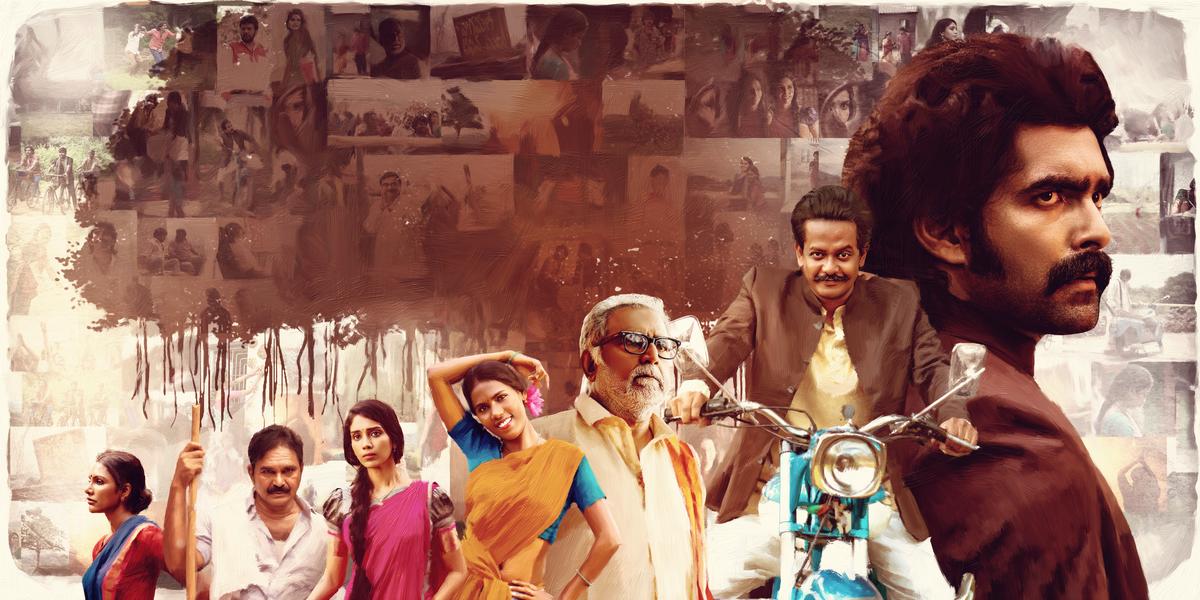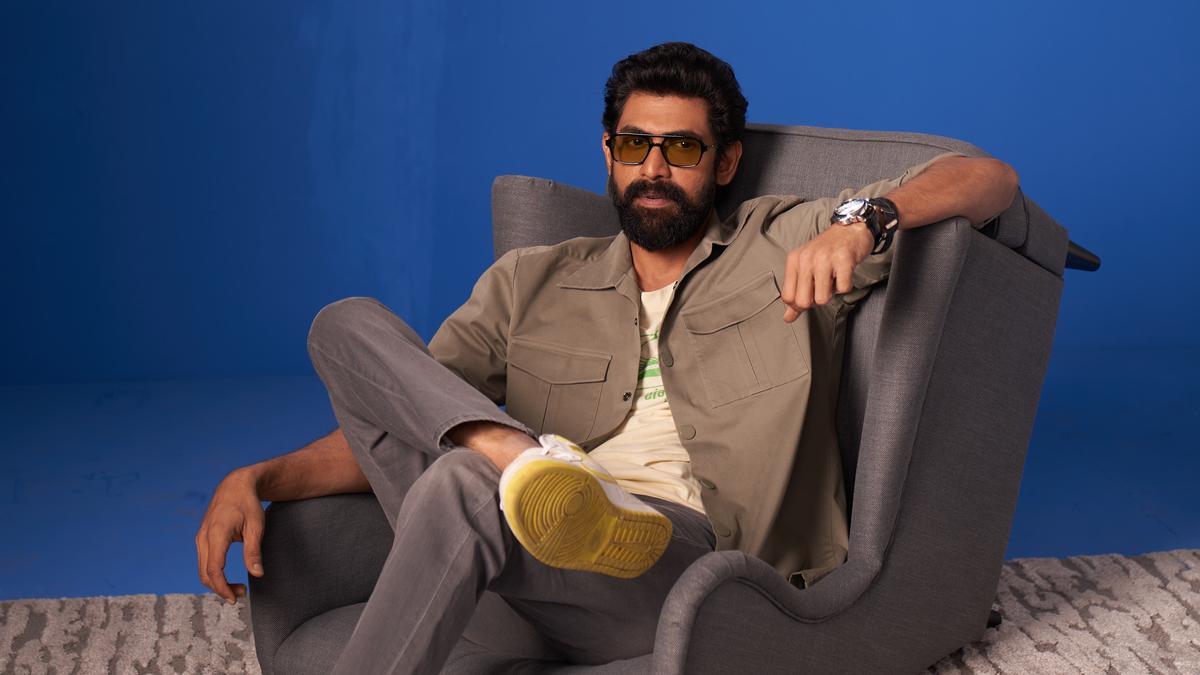In 2018, New York-based cardiologist Praveena Paruchuri and writer-director Venkatesh Maha approached producer Sureshbabu and his son, actor-producer Rana Daggubati, with their Telugu indie film Care of Kancharapalem(CoK). Praveena had produced and acted in the film. Sensing its potential, Rana and Sureshbabu came on board to distribute it.
Seven years later, Praveena is making her directorial debut with Kothapallilo Okappudu, releasing on July 18. Once again, Rana is backing her work.
Rana Daggubati
| Photo Credit:
Special Arrangement/Eshaan Girri
Chatting at Ramanaidu Studios in Hyderabad, Rana reflects: “Independent films often get lost in a market dominated by bigger productions. Dad watched CoK and felt it was something I might want to support. It didn’t follow the usual rules of commercial cinema, but it was entertaining and full of heart. I was proud to put my name to it, and even more so when it resonated with audiences. It also brought me in touch with Praveena and Maha, whom I wouldn’t have met in the regular cinema space.”
Rana’s relationship with indie cinema goes back further. In 2004, he produced Bommalatta (A Belly Full of Dreams). “Even though I come from a film family, I didn’t know how to get that film to audiences.” Multiplexes hadn’t taken off then, and hardly anyone turned up. “The only money we made was ₹50 lakh from Doordarshan after it won two National Awards,” he says, laughing.

The revival
Over time, Rana transitioned into acting and shot to fame playing the antagonist in the Baahubali films. Yet, his eye never left the indie film space. He revived Spirit Media, the company he had founded in the early 2000s to focus on animation and visual effects, to champion smaller, heartfelt films. Since then, Spirit Media has backed titles such as Pareshan, 35: Chinna Katha Kaadu, Bapu, 23, and the Telugu version of Charlie 777.
Their latest offering is Kothapallilo Okappudu (Once Upon a Time in Kothapalli). In the lead-up to its release, the team has been hosting select preview screenings across cities to build buzz through word of mouth.
Praveena recalls being caught up with work in the US during the pandemic, shortly after co-producing her second film, Uma Maheshwara Ugra Roopasya, with Shobu Yarlagadda and Prasad Devineni. “I hadn’t planned on returning to India in 2022–23,” she says. “But when Aparna Malladi, who had mentored many filmmakers, including Maha, fell seriously ill, I came to visit her. She has since passed away. During that trip, a friend shared the story that eventually became this film.”
Multitask by design
Praveena Paruchuri
| Photo Credit:
Special Arrangement
Praveena chose to produce, direct, and act in a key role in Kothapallilo Okappudu — not out of ambition, but necessity. “As a second-generation Indian American with no industry connections, no one was going to call and ask me to make a film,” she says. “I had to create my own opportunities.”
What drew her in was the story, especially the character of Ramakrishna, the protagonist. “I didn’t know who to cast at first. Then, by chance, I met Manoj Chandra in New York and felt he was perfect for the role,” she says. Having worked on CoK, which featured several non-actors, she was inspired by the approach of filmmakers like Mira Nair and Rajnesh Domalpalli, who held acting workshops and worked closely with newcomers. “I wanted to follow a similar path, in my own way.”
Though Praveena and Rana stayed in touch occasionally — she fondly recalls meeting him at Comic Con in the US — it was not until Kothapallilo… was completed that he saw the film. “It’s an honest story about ordinary people,” says Rana. “It explores belief, a complex subject, but in a way that’s simple and open-ended.”
What stood out to him most was the response after a test screening. “Right outside my office, in the corridor, I overheard a few people discussing the film. One person shared a story from his village, another offered a completely different view. They didn’t know I was listening, but I was struck by how the film got them thinking.”
He was equally intrigued by how a team based in the US — Praveena, Manoj, and cinematographer Petros Antoniadis — could tell a rural Telugu story through a globally fluent visual language. “They looked at our culture through a fresh lens,” he says.
With 2024 seeing a few small-budget films like 35 and Committee Kurrolu succeed at the box office, Rana believes human stories, regardless of scale, can connect with audiences. “And cinema,” he adds, “is best experienced on the big screen, without distractions.”
Finding the niche

The ensemble cast of ‘Kothapallilo Okappudu’
| Photo Credit:
Special Arrangement
Spirit Media recently acquired the Indian distribution rights for Payal Kapadia’s All We Imagine As Light, and the experience brought with it fresh insights. “The film, which features a lot of Malayalam, performed unexpectedly well in the North, particularly Delhi, and even in Karnataka. Surprisingly, it didn’t do as well in Kerala,” says Rana. “With Charlie 777, we still had audiences in the eighth week. What I’ve come to realise is that there is an audience for every kind of cinema. Rather than obsess over box office numbers, the challenge is finding the right screens and release windows for smaller films.”
Rana is proud that films he has backed — like Care of Kancharapalem — “have aged beautifully.” While his family’s banner, Suresh Productions, handles larger commercial releases, he continues to champion indie and experimental cinema through Spirit Media.

Having just marked a decade since Baahubali: The Beginning, Rana reflects on how scale has become more accessible. “With visual effects and AI, scale is now in everyone’s hands. What really matters is a good story.” As for the current obsession with box office stats, he is candid: “Most of those numbers are inflated, it’s just a dopamine hit,” he says with a laugh.
When asked whether he consciously gravitates towards arthouse cinema, Rana clarifies, “I’m drawn to films with a distinct voice. I grew up in Film Nagar and it still excites me to see stories and characters that reflect the cultural diversity of India.”
Established and new
The choice of onboarding an American cinematographer, Petros Antoniadis, Praveena explains, was to capture the rural terrain with a fresh perspective.
While composer Mani Sharma brought in the 90s nostalgia to the songs, she chose Varun Unni for the emotionally-stepped background score.
Both Praveena and Rana state that its charm lies in presenting newcomers like Manoj and Monika alongside seasoned actors such as Benerjee and Ravindra Vijay. Praveena highlights the dusky Usha Bonella, nicknamed ‘andham’ (beauty), while Rana points out how an experienced actor like Banerjee realistically portrayed his character and how Ravindra Vijay might become the crowd favourite. “You will like him because he is so good at being evil. He’s like a meme!”
Plans are in motion to take the film to international film festivals, but Praveena is firm that it will stay true to its Indian roots —with song and dance intact. “I don’t want to create a separate ‘festival cut’,” she says.
Rana adds, “Cinema can take us into spaces we least expect. When I watched Sinners, I was blown away. It started as a gangster film but evolved into something entirely different. Kothapallilo… has a similar moment of surprise.”

